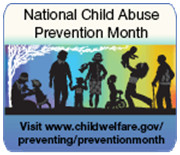The NICHD highlights research on child abuse and neglect

Child abuse and neglect affect about 6 million children in the United States each year, according to the Administration for Children and Families (ACF). In more than 80% of cases, the abuse is from a parent.
Providing support for parents at risk for child abuse is critical to protecting children and ending the cycle of abuse. Each April, the Children’s Bureau, within the ACF, observes National Child Abuse Prevention Month to educate and empower families and communities to protect and care for victims of child abuse and neglect.
The NICHD adds to these efforts by supporting research to identify effective interventions that can help reduce the risk for abuse and by increasing our understanding of the short- and long-term effects of abuse and neglect on children and families. Select a link below to learn more about National Child Abuse Prevention Month and related NICHD research.
Strengthening Families and Communities
NICHD Research on Child Abuse
More Information
Strengthening Families and Communities
This year, National Child Abuse Prevention Month focuses on providing families, communities, and organizations with ways to promote child well-being. The ACF has identified six protective factors that, when present in families and communities, increase the health and well-being of children and families. These protective factors include:
- Nurturing and attachment
- Knowledge of parenting and child development
- Parental resilience
- Social connections
- Concrete supports for parents
- Social and emotional competence of children.
Research shows that these protective factors are linked to a lower incidence of child abuse and neglect. To help families and communities build these protective factors into their daily lives and activities, the ACF provides tip sheets and other information in both English and Spanish. Other materials available to communities as part of National Child Abuse Prevention Month include a 30-day calendar of activities and a resource guide for service providers, which highlights state and national activities.
National Child Abuse Prevention Month is just one of the programs supported and led by the Children’s Bureau and the ACF related to promoting child well-being. Their efforts continue throughout the year to strengthen families, prevent child abuse and neglect, and ensure that children in need receive care and treatment.
NICHD Research on Child Abuse
NICHD research complements and contributes to the work of the Children’s Bureau. Much of the NICHD’s research on child abuse and neglect is supported through the Child and Family Processes and Child Maltreatment/Exposure to Violence Program, within the Child Development and Behavior Branch (CDBB), and the Pediatric Trauma and Critical Illness Branch (PTCIB), both within the Division of Extramural Research. Valerie Maholmes, Ph.D., C.A.S., manages the Program and the PTCIB.
“The main goals [of this research] are to make sure that children are healthy and wanted and have the opportunity to live to their potential,” said Dr. Maholmes. “We research the kinds of medical treatments and interventions that children must have to make sure they are able to survive critical illness and injury and have good quality of life.”
Current NICHD-supported studies are exploring ways to detect and diagnose child abuse and neglect, evaluate the impact of child abuse and neglect, identify factors that help children cope with abuse and neglect, and develop intervention strategies to reduce the risk. The NIH Research Portfolio Online Reporting Tool provides a listing of NICHD-supported projects on child abuse and neglect.
In April and throughout the year, the NICHD supports research to understand the effects of child abuse and neglect, identify research gaps, and help support and strengthen families and communities. Agencies, such as the ACF, and organizations rely on this important work to help inform their efforts and activities to protect our most valuable resource—our children.
More Information
For additional information, select one of the links below:
- NICHD Resources
- Division of Extramural Research
- Previous NICHD Spotlights on child abuse and neglect:
- Related A to Z Topics:
- Administration for Children and Families (ACF)
- National Child Abuse Prevention Month Web Site and Materials
- Children’s Bureau
Originally Posted: April 23, 2013

 BACK TO TOP
BACK TO TOP